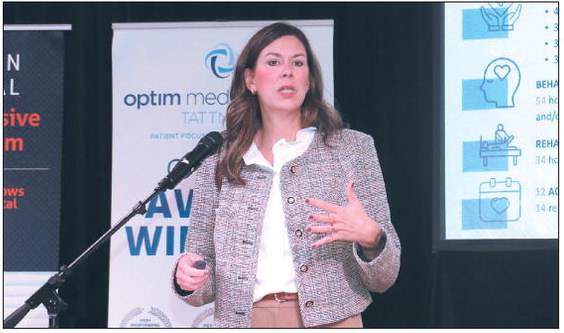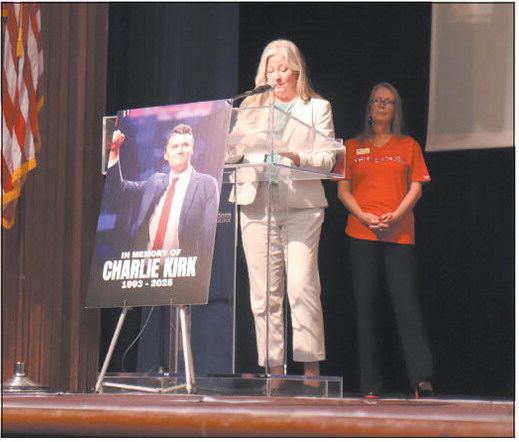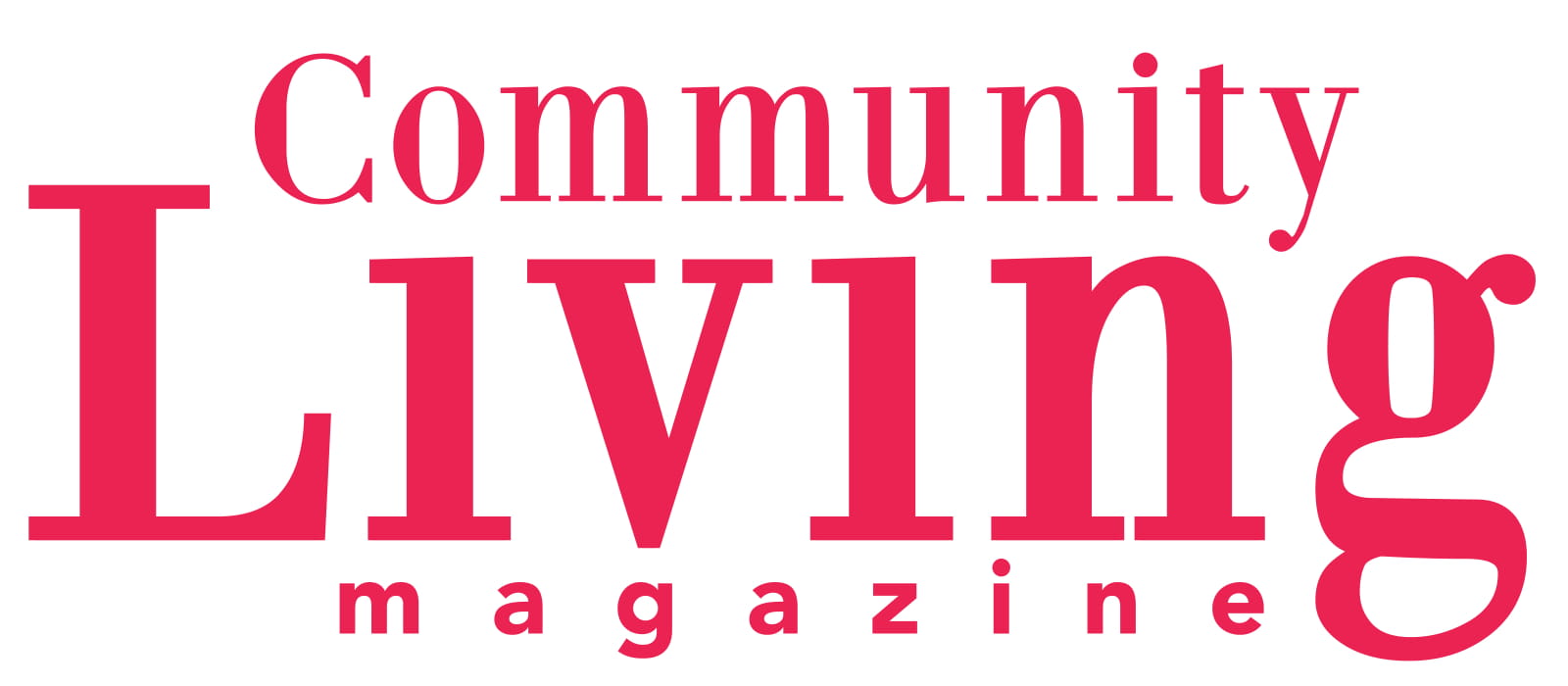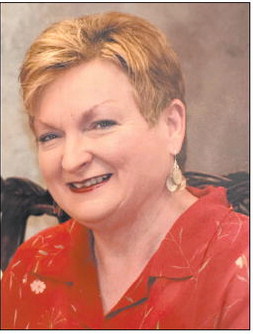Caylee Noggle Sheds Light On Rural Healthcare Challenges


mrandolphadvance@gmail.com
Georgia Hospital Association President Caylee Noggle informed the community of several issues plaguing rural healthcare during the Greater Vidalia Chamber State of Healthcare address on Thursday, October 2.
Noggle began by sharing the Association’s mission, as she emphasized the group’s importance in ensuring that Georgians had adequate healthcare resources. “Our mission is to be the leading advocate and supporter for hospitals in the state in support of a healthier Georgia. That last part is really important – our priority is helping to create policies, regulations, financial policies, legislative changes, [and] whatever there needs to be in order to support and encourage a strong and sustainable network of hospitals across the state in order to support a healthier Georgia. So, in that regard, there is a lot more than just our advocacy work; continued from page
we also work in patient safety, quality improvement, and all sorts of different things that really we hope leads to a healthier population in Georgia,” she explained.
She also informed attendees that rural healthcare differed some from other hospitals or clinics in larger areas, as they presented unique challenges and issues that had to be solved differently from those in larger areas.
According to Noggle, the Georgia Hospital Association has around 150 members, totaling around 180 hospitals across the state. These hospitals generated a $122 billion impact on the state economy last year – an impact which Noggle argues is unmatched by other industries. “I would challenge you to find any other industry in the state – including agriculture and all of our other really important services and industries – that comes close to that $122 billion,” she told the audience.
She explained that rural Georgia hospitals had around a $1.5-$1.7 billion impact on the state, and supported around 16,000 jobs. Because of these large amounts, Noggle urged attendees to view healthcare as a vital resource in the community, as she stated that excellent healthcare served as “a clear sign of a thriving economy, supportive community, and access to valuable resources.”
“We have to start thinking about healthcare as critical infrastructure. When we we talk about water, sewer, emergency preparedness, and resilience, all of these types of things, it’s going to be really hard to attract businesses to south Georgia if there is not a sustainable network of healthcare access, including hospitals across the state,” Noggle remarked.
Currently, there are 66 rural hospitals across the state, and an additional 2 rural emergency hospitals, which treat emergencies but have no inpatient capabilities. These hospitals total around 3,700 inpatient beds available to the public – 147 of which are obstetrician beds.
She discussed the challenges of rural hospitals, stating, “You hear a lot of talk about hospitals closing and why rural hospitals struggle so much. We really have dove in about the why of those struggles. I’m a former Chief Financial Officer, I’m a data nerd, and it comes down to economics. It’s really a lot about healthcare economics.”
According to Noggle, a major financial challenge that burdens rural hospitals is the lack of contracted payer rates, which is the money received by the hospital from insurance companies. She explained that many insurance companies do not cover the full cost of care, which can cause deficit within rural hospital revenues.
“The negotiating power of small, independent hospitals can’t possibly logically really measure up to the same negotiating power of the large multihospital system or somewhere urban can. Certain markets definitely have different kinds of economic dynamics and certainly, [these smaller hospitals] cannot negotiate for the same payer rate,” she continued. “We measure [the success of revenues with the amount of cash reserves] on days on hand. I was talking to someone yesterday who had 90 days of cash on hand. I know some others that probably have 5 days of cash on hand. They cannot withstand a storm literally or figuratively if something bad were to happen.”
She added, “When all of their cash gets tied up in emergencies, we usually get a phone call saying, ‘We might not be able to make payroll, what do we do?’ It becomes a very tricky puzzle piece – we have adept CEOs and administrators across the state and others that really know how to rob Peter to pay Paul. It becomes a game of how do we fit this puzzle together? How do we not pay this bill to pay this bill? We can certainly pay our people because that’s our most valuable resource. But it’s a lot of economic pressure, especially on rural hospitals, that doesn’t necessarily sit the same way everywhere.”
Noggle explained the dynamics of payers, as she stated that commercial insurance companies generally pay more, while Medicare pays 90% of the cost of care on average and Medicaid pays around 75% of the cost of care on average. “That’s about 70% of patients across rural Georgia – including north Georgia as well – that are being funded by a payer source that pays less than the actual cost of care. Usually, you use those commercially covered patients – meaning, some of you that have good payers – to subsidize that cost, but there’s always a need for capital infrastructure improvements – new technology, workforce, etc.,” she said. “These pressures in a payer mix that doesn’t cover the cost of care start to become really, really challenging to manage.”
She informed the audience that Medicare is the fasting growing payer in Georgia, as its patient population had grown by 40% over the last decade and was expected to increase by an additional 40% over the next decade. “That’s because every day in America, 10,000 folks turn 65 and move on to medicare. We are also at an all-time low birth rate. So, normally, as we talked about, these commercially insured people in the workforce have people come up and subsidize the older population as that older population gets older. In rural Georgia, that older population is also more medically complex – they require higher community care and show up to the emergency room and facilities with less primary care and preventative care. They are higher cost, and there are less people being born to come up behind and fill that gap,” Noggle clarified.
“We are really starting to be at the tipping point across all of the healthcare spectrum that as the population continues to get older, more and more of the care that our healthcare providers are providing is being paid for by a government fund source that doesn’t cover that cost, and there’s not enough people coming up behind it with adequate cost, what are we going to do? All of those dynamics put a lot of pressure on hospitals’ finances and operating margins for most of our hospitals,” she emphasized.
Noggle also remarked that not-for-profit hospitals would not solve the issue, as these facilities had to make money to be able to continue to serve the community efficiently. “You have to have a positive operating margin really to run any business to reinvest into that business – to buy a new roof, to get
Hagan takes a moment to memorialize the late State Represen tative Mandi Ballinger, who recently passed away from cancer.
Photo by Makaylee Randolph continued from page
a new MRI machine, to provide the new types of services, technologies, and care delivery methods that your community expects. Your community wants to walk into a hospital like [Memorial Health] Meadows [Hospital] that feels great and shiny and has new paint and fresh floors. When your hospital starts degrading, people lose confidence in it and they’re going to drive further down the road. You need to have a positive operating margin to do that. You also need a positive operating margin, like I said before, to weather the storm.”
She referenced the need for support from the hospitals during the Hurricane Helene disaster to support this belief, as she stated the hospitals served as a cornerstone in the community during their time of need. “Hospitals did not close. They were places that community members ran to when they needed help. I’m sure you have your own stories, but we have photos where patients on dialysis had to show up at the hospital to plug in their oxygen tanks. There was no water, people were washing clothes, and staff were parking their cars and just trying to make it into the building. It was our hospitals that kept it going. They didn’t get paid for that. Those extra services they provide is part of community benefits to weather a storm,” she explained.
Noggle stated that last year, 28% of hospitals in Georgia lost money, and that in Rural Georgia, 46% of facilities had a negative operating margin.
In addition to these difficulties, hospitals are also struggling to keep up with state and federal standards, as around 100 regulatory bodies are regulating things in the industry. “They’re all changing things every day and you’re paying people just to keep up,” she remarked.
Yet, amidst the challenges, Noggle assured attendees that the Association was seeking solutions to the issues in hopes of continuing to create a healthier Georgia.
“Our goal is to really look for opportunities to improve healthcare in Georgia in hospitals in particular. Our mission then has five strategic health initiatives around access to quality care, behavioral health, rural health, healthcare liability reform (also called tort reform), and workforce. There is not one single thing that we can do in Georgia to suddenly improve access to care and problems are solved. There is no single silver bullet. We have to back that up and look at the individual levers that we can apply pressure on and put policy around to start to improving access to care,” she emphasized.
The State of the Healthcare event was sponsored by the Greater Vidalia Chamber as a part of their initiative to inform citizens about the surrounding community. For more information on future “State of” events, call (912) 537-4466.

REMEMBERING HER COLLEAGUE – State Representative Leesa

A FULL STAGE – Four State School Superintendent candidates came to Vidalia on Tuesday, October 14, for a candidate forum. L to R: Moderator Lawton Sack, Former State Representative Mesha Mainor, Dr. Randell Trammell, Toombs County Republican Party Chair and Event Host Trish Poole, Dr. Fred “Bubba” Longgrear, Dr. Nelva Lee.Photo by Makaylee Randolph





